
Emerging Canada Cruise: A North American Adventure
Danielle Fear discovers cosmopolitan cities, quaint seaside villages and remote off-shore islands on an epic cruise to Canada
After several days at sea, we had finally arrived at St John’s, Newfoundland. The Witless Bay Reserve is home to the largest puffin colony in North America and that’s where I was heading. The stunning birds are humorously known as the ‘clowns of the sea’ due to their comic faces.
The boat trip across to the reserve also allowed us to get up close to some colossal icebergs and other ‘bergy bits’ as our guide referred to them. We’d spotted several from the ship as Saga Sapphire entered port, but these were so much bigger and had most likely made their way down from Greenland.
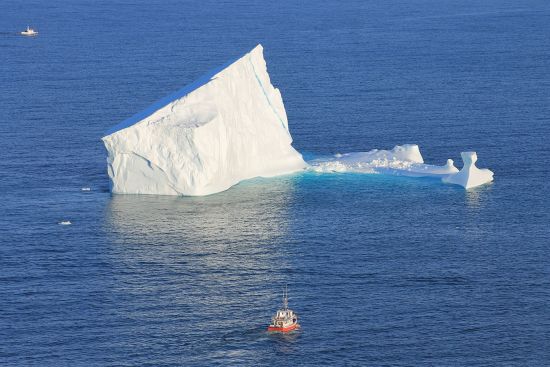
I was on Saga’s 30-day Canada cruise aboard Saga Sapphire, sailing from Dover and then back via the Azores. Entitled Emerging Canada, this is an apt name to describe this epic sail during the country’s beautiful springtime.
Following St. John’s, our second stop was Gaspé, which is located in the Gaspésie–Îles-de-la-Madeleine region of eastern Québec in Canada. The quaint town is small in size, so took me less than two hours to explore. Here you can you can discover the region’s culture and history at the Musée de la Gaspésie, or learn about the area’s first inhabitants at the Micmac Interpretation Site of Gaspeg.
My time in Sept-Îles was spent mostly on water, having booked myself onto the Archipelago Scenic Zodiac tour. We didn’t stick to the exact scheduled itinerary, however, because we spotted a blue whale within minutes of leaving the pier, which was the first time I’d ever seen one of these amazing creatures up close. We stayed admiring it for some time before heading across to see the hundreds of birds on Corossol Island, which is one of the most important bird sanctuaries in eastern Canada.
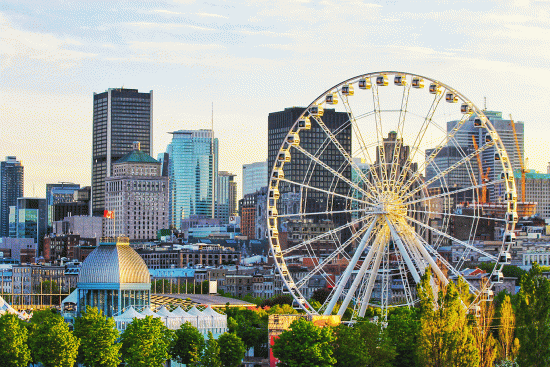
After being immersed in Canada’s nature and wildlife, I was ready to experience its thriving metropolis and as luck would have it, Montreal was our next stop. The city is famous for being the beating heart of Canada, alive with a plethora of music, dance and comedy festivals all-year round. My excellent local guide René showed me around Downtown, which is a notable contrast to the historic Old Town, complete with impressive skyscrapers, modern artwork and a great shopping scene.
The downtown area is also home to the Montreal Museum of Contemporary Art, Montreal Museum of Fine Arts, The Bell Centre and other cultural institutions well-worth a visit. It’s also where you’ll find the world’s largest underground city, with indoor access to over 1,600 shops, restaurants, offices, businesses, museums and universities, as well as metro stations, train stations, bus terminals, and tunnels that extend all over downtown. This subterranean city is where Montrealers retreat to during the bitter winter months.
In the afternoon, I visited the Observatoire Place Ville Marie. I’d read about it before leaving on the cruise and although I suffer from vertigo, I knew it was an experience not to be missed and it turns out I was right. The 360°, panoramic vista across the city stretched so far out that on one side, you could just make out New York.
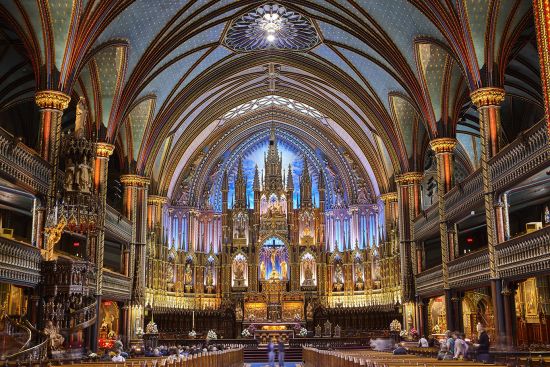
On our second day in Montreal, I made my way to the Notre-Dame Basilica, which was located opposite where the shop was docked. Arriving at 10am, I queued for no more than five minutes before paying $8 for my ticket and entering. The basilica was built between 1824 and 1829 and it truly is a masterpiece of Gothic Revival architecture. The interior, reminiscent of Paris’s Sainte Chapelle, is the work of architect Victor Bourgeau.
Our next port of call was Québec City. My first tour was to Sainte Anne de Beaupré and Montmorency Falls. We had a scenic drive before arriving at the basilica which, from the outside, is pleasing to look at, but is nothing in comparison to what you’ll find inside. Featuring sculptures, paintings, mosaics and more than 200 stained glass windows, the renowned pilgrimage site is a fitting tribute to Sainte-Anne, the grandmother of Jesus Christ.
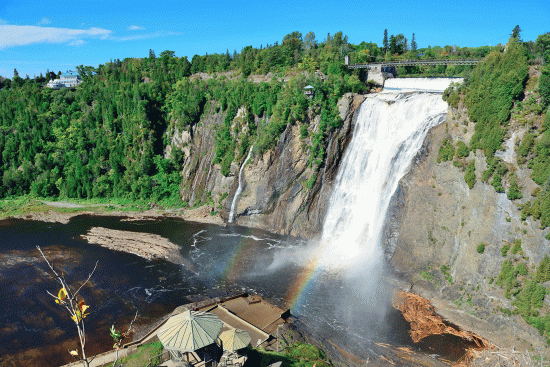
Following the basilica, we and made our way to Montmorency Falls. The falls, 30m taller than Niagra Falls, cascade down a 272-foot cliff and into the shore of the St Lawrence River. There are several walking trails and viewing platforms, as well as a small park, restaurant and gift shop.
The most iconic and famed site in Québec is undoubtedly Fairmont Le Château Frontenac. Perched on top of Cap Diamant, the grand building soars above the city’s skyline and is situated inside the walls of old Québec, a UNESCO World Heritage Site, and by the cliffside boardwalk, Dufferin Terrace, offering perilous views of the Saint Lawrence River. Designed by architect Bruce Price during the late 19th century and with its turrets, towers and spires, is reminiscent of a fairytale’s palace. Today, it is home to Fairmont’s luxury five-star hotel.
After a quick change and refresh on board, I was back on the gangway and heading out for my third and final tour of the day. I spent the evening at a Sugar Shack which began with live music and food, before we were shown to an adjacent hut where we could make our own ice maple taffy and learn how this sugary, delightful treat is made.
As our guide informed us, the maple tree must be between 45 and 50 years old before it is tapped. To tap the tree, a hole is made in the trunk and then a small tube inserted to extract the syrup. One tree can only be tapped a maximum of five times per year, otherwise it could become sick, or worse, it could die.
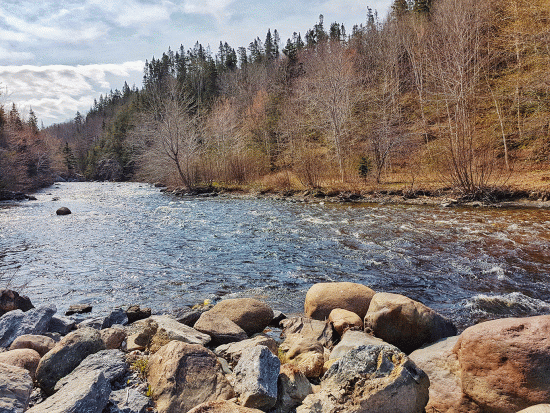
Following Montreal and Québec City, our next stop was at Corner Brook was another relatively small port and a welcome break from the hustle and bustle of city tours. We made several stops at points of interest, but my favourite was at Marble Mountain, home to the Heritage Tree.
This incredible monument is a 52-foot, four-foot-six-inch wide pole weighing a whopping nine tonnes. It was a true work of art and featured many carvings depicting Newfoundland’s history from the arrival of the Viking’s in 999AD right up to modern times, including puffins, stamps, icebergs, Churchill Falls, ships and a Newfoundland 20 cent coin.
The following morning, we arrived in the port of Sydney, Nova Scotia. I spent some time walking along the boardwalk and through the main street. I returned to the ship shortly before departure and sat back with a drink in hand as we sailed to our final Canadian port, Halifax, Nova Scotia.
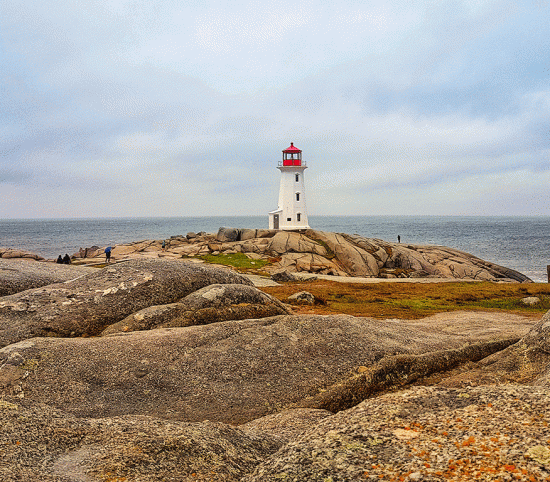
Peggy’s Cove was my morning choice for Halifax. While fairly desolate no doubt due to the pouring rain, I could imagine on a dry and sunny day it would be a hive of activity with visitors exploring the rock formations, enjoying a picnic, and experimenting with the endless photo opportunities. The small fishing village is home to just 40 people and sits on top of a solid stone inlet. It’s also home to Peggy’s Point Lighthouse, one of the most photographed in the world.
In the afternoon, I took myself off on the shuttle bus and to the Atlantic Maritime Museum to see the Titanic exhibit. It’s on the second floor and features the largest collection of Titanic artefacts in the world, including a chopping board, deck chair, a section from the ships’ grand staircase and a lifejacket fragment reportedly worn by John Jacob Astor, to name a few.
There are also a few items on display from those that were lost on that terrible night, including a pair of leather gloves that were recovered from the body of Charles Hays, President of the Grand Trunk Railway. His body was the first to be recovered and he is now buried in Montreal’s Mount Royal Cemetery.
Another sad sight was that of a tiny pair of shoes that had belonged to the “Unknown Child”. For more than 100 years, the little boy was unknown, but in 2010, scientific studies revealed him to be 19-month-old Sidney Leslie Goodwin of Wiltshire, England. His body was found by the Mackay-Bennett and it was the sailors aboard this vessel that paid for his monument, which featured a copper pendant that read “Our Babe”.
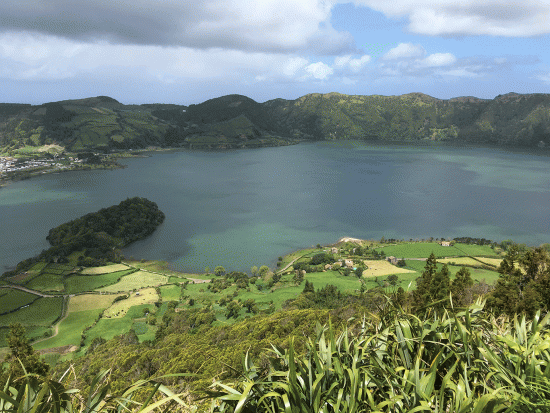
We sailed on from Halifax and spend the next three days at sea immersed in fog as we headed back home via the Azores. Our final port of call was Ponta Delgada. We drove through the western part via the coastal route, before we arrived at Feteiras, where the road climbs to Sete Cidades (‘Seven Cities’).
We stopped at the crater for a photo opportunity and were greeted with a rather incredible sight. The crater is 1,900 feet above sea level and eight miles in circumference, and from our view point on the very edge, we could see two distinct lakes below, one green and one blue. The blue lake reflects the sky and the green lake reflects the lush vegetation of the crater walls, resulting in the most beautiful spectrum of colours.
Sadly, Saga Sapphire will leave the Saga fleet in June 2020, but there is still time to enjoy this beautiful ship before she bids a fond farewell. Spirit of Discovery, the first of two new build vessels for Saga will enter service in July.
for more information and to book, visit saga.co.uk.